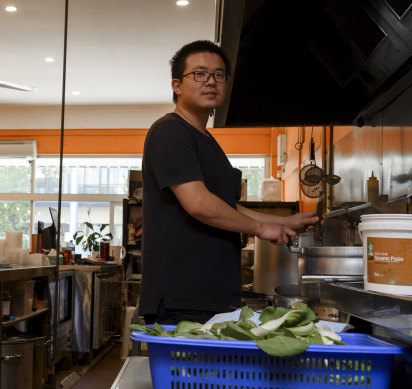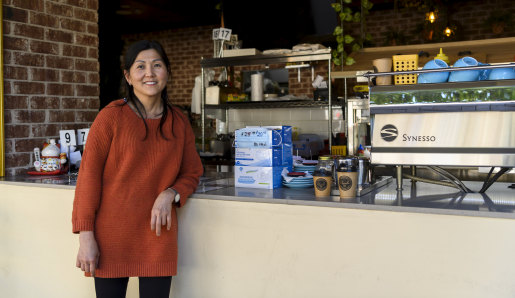- Exclusive
- National
- NSW
- University
This was published 4 years ago
'It's totally dead now': Overseas student exodus cost Sydney's economy $2.5b
By Anna Patty and Matt Wade
The exodus of international students due to the COVID-19 pandemic has cost Sydney's economy $2.5 billion as small businesses go quiet and rental properties remain empty.
New modelling from Victoria University's Mitchell Institute shows the number of international students living in Australia will halve, dropping by up to 300,000 by mid next year, if international borders remain closed. The research estimates this will result in a $10.7 billion annual loss to the broader national economy.
About 80,000 overseas students are estimated to have already left NSW due to the pandemic.
Small businesses along Anzac Parade in Kingsford are among those struggling to survive as a result of lost trade.

Yu Fisher, manager of Mr Xiaomian Noodle Bar.Credit: Rhett Wyman
Yu Fisher, who manages Mr Xiaomian Noodle Bar in Kingsford, said his and other businesses along Anzac Parade had relied on international students from the University of NSW and were now struggling.
"Most of the restaurants in Kingsford rely on Chinese students," he said. "We were mainly full all day before the coronavirus pandemic."
Greater Sydney has so far lost 72,000 international students, resulting in an estimated loss of about $2.5 billion to the broader city economy.
Report author Dr Peter Hurley said the loss of international students was spread across inner Sydney suburbs and others with Chinese communities, including Hurstville. Based on Australian Bureau of Statistics figures, the average international student contributed about $35,000 to the broader economy each year.
"I would estimate the current situation would mean an annual reduction of about $100 million associated with international students living in Kingsford and about $70 million for international students living in Kensington," Dr Hurley said.
Kingsford has, so far, lost about 2840 international students and Kensington has lost about 2000. The report shows international student visa applications, where the applicant is outside Australia, have dropped by 80 to 90 per cent since the same time last year, suggesting there is little pent up demand.
"The initial population shock affected regions where Chinese international students lived, but future declines are likely to involve international students from all countries," Dr Hurley said. "This means the impact of falling international student enrolments will become more widespread."
The owner of Glory Printing on Anzac Parade in Kingsford, Pang Gunawan, said it was the quietest he had seen in the 27 years running his printing business. Before the COVID-19 pandemic students were lining up outside.
"It's totally dead now," he said. "This is the worst ever, in my experience." "We've had a 75 per cent drop in business. It's very stressful."

Glory Printing owner Pang Gunawan.Credit: Rhett Wyman
Mr Gunawan has warned his six employees that they may lose their jobs after he stops receiving JobKeeper in March.
Queenie Thai, who runs Phoodle Eatery, said her restaurant was always packed before the pandemic. "We have lost about 70 per cent of our business since COVID. People rely on the international students here. It is the quietest I've ever seen it."

Queenie Thai, a worker at Phoodle Vietnamese Eatery.Credit: Rhett Wyman
Sam Karatasas, principal of Raine and Horne Kingsford, said properties that were rented for about $600 were now renting for $200 less "because the international students aren't here".
The Mitchell Institute data shows rental vacancy rates have increased by more than eight per cent in Kingsford, Kensington, Redfern, Chippendale, Macquarie Park, Pyrmont, Ultimo and by more than 12 per cent in the Haymarket area.
Domain data also shows rental vacancies have increased and rents have fallen by more than eight per cent in Kingsford and Kensington, more than 15 per cent in Pyrmont and Haymarket and by more than 10 per cent in Chippendale since last year.
Independent economist Terry Rawnsley said international education had become an increasingly important contributor to Sydney's economy, especially in inner-city areas.
"The education sector is more labour intensive than some other exports, like mining, and that means you get more jobs for every dollar of exports compared to the more capital intensive sectors," he said.
Rawnsley has previously estimated total employment in tertiary education in the inner-Sydney region jumped by 37 per cent between the 2011 census and 2016 census. It was a similar story in inner-Melbourne where tertiary education employment was up 28 per cent in the period.
The broader Sydney economy has also benefited from the spending by international students, and their visiting friends and relatives, especially on accommodation, dining, retail and entertainment.
Despite the disruption caused by the pandemic, Rawnsley predicted Australia's relatively successful response to the pandemic would assist the international education sector over time.
"If international students are weighing up where to study, Australia might look more attractive than places like North America or Europe," he said.
A spokeswoman for the University of NSW said it was discussing the safe return of international students with state and federal governments. She said ABS data showed international education supports 250,000 jobs in the wider economy.
Sydney Business Chamber executive director Katherine O'Regan said international students were critical to the local economies around university hubs.
"There has been a significant impact on unis, local ecosystems and local streets – whether it is Anzac Parade, or Pyrmont and Broadway," she said. "The smaller businesses are not getting the foot traffic they used to.
"As we try to get Sydney to be a truly night-time economy you would want to see a return of the students to help build that."
NSW Tertiary Education Minister Geoff Lee said NSW Treasury figures showed each international student contributed about $50,000 to the state economy including through university fees.
"International students play a valuable part in not only university income but also to drive local demand in terms of accommodation, food and hospitality and local businesses," he said.